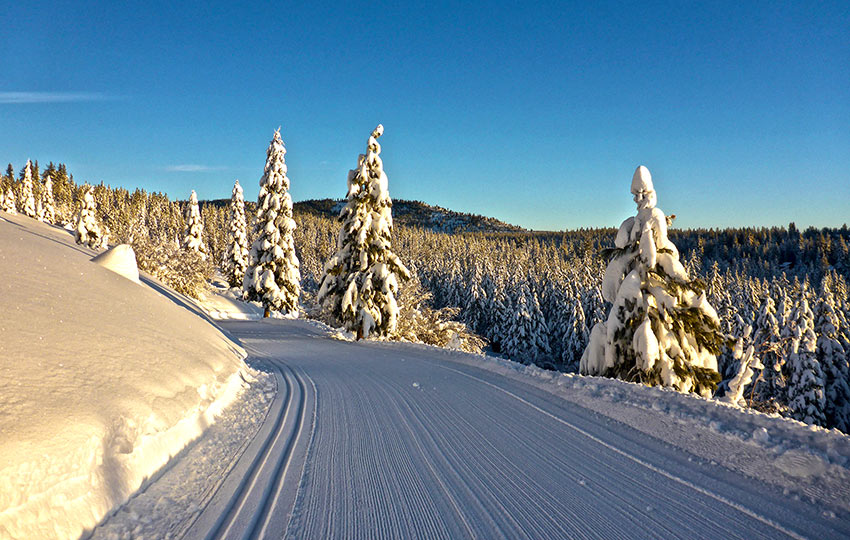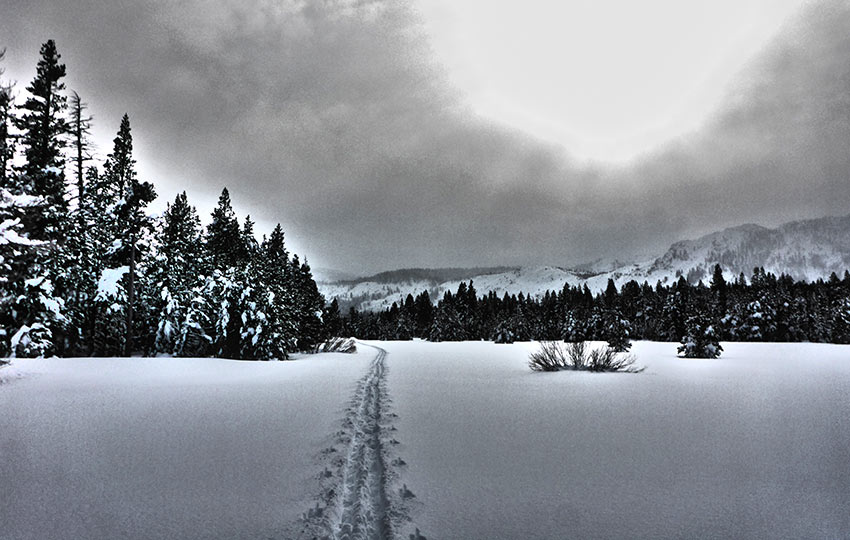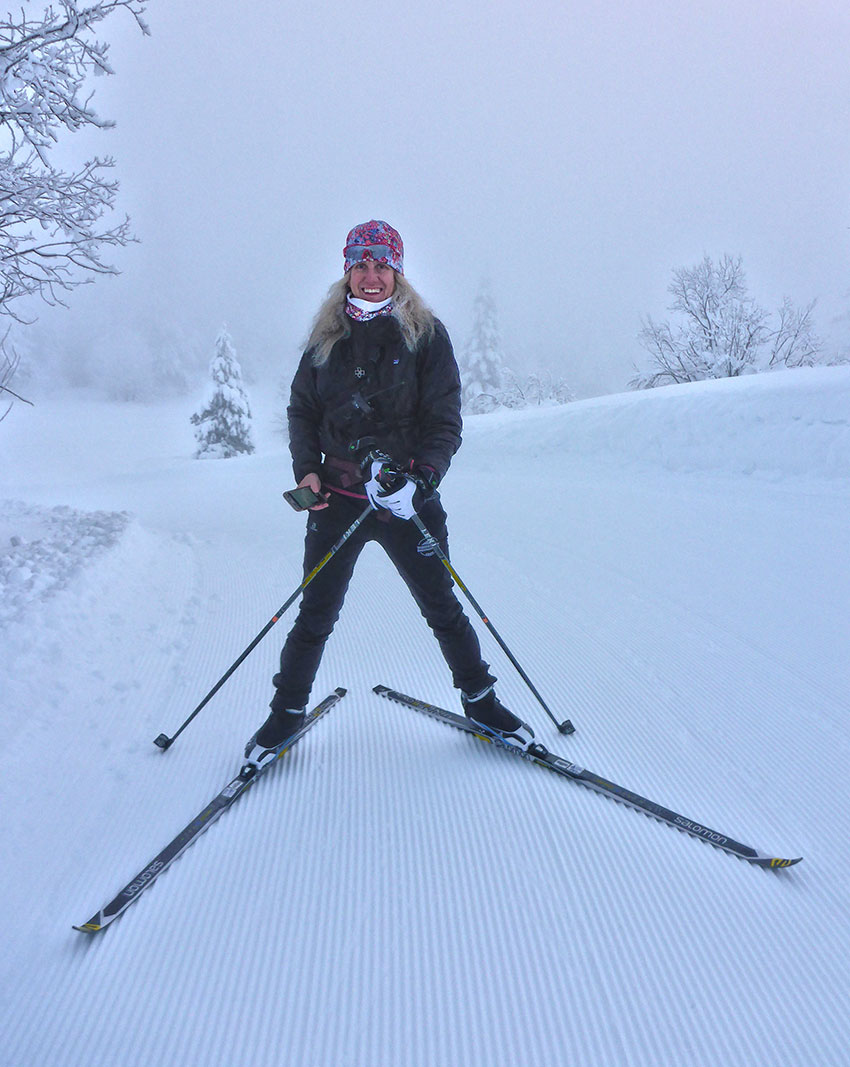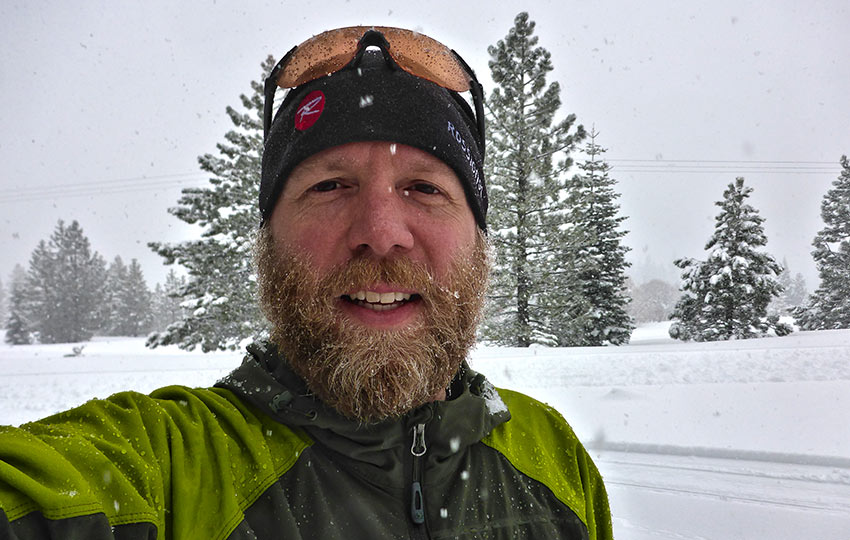
Skis were created, as you might expect, primarily to be a mode of transportation over snowy terrain. For example, people used them to travel from one place to another and to chase down wild game during the winter. So, skis were (and still are!) designed to provide the fastest and most efficient means of travel across snow.
Although this article is about cross-country skiing, downhill skiing having been around since the 1800s, is arguably a more popular form of skiing. That said, cross-country skis are the original skis … like thousands of years old original.
Support Tahoe Trail Guide with a financial contribution via PayPal (single contribution) or Patreon (reoccurring contributions). Your support of Tahoe Trail Guide is very much appreciated!

Contemporary cross-country skis are clearly superior to their millennia-old predecessors. And, skiing as a means of survival has taken a back seat to skiing for enjoyment and sport. But the drive for efficient and effective travel over snow remains. This is especially true for locations that experience snowy months for half or more of the year.
I mean, you have to have some healthy activity to keep you sane during the winter!
People often equate cross-country skiing with the image of a sole skier effortlessly gliding across an open meadow or an undulating landscape.
Clearly, there are countless other scenarios and environments in which to use cross-country skis. But they nearly always involve skiing or gliding across variable terrain. Hence, the term “cross-country” skiing. I realize this notion is probably not revelatory. However, I just wanted to clarify that it would be a stretch to equate xc skiing with standing in a lift line and riding a chairlift up a mountain. Then, after bombing down a steep descent, doing it all over again.
There’s no question that xc skiing and alpine skiing stem from the same origin and share some basic characteristics. But they’re definitely not the same.
To Cross-Country Ski is to Overcome Friction & Gravity
Friction is the naturally occurring force that prevents two surfaces (or layers in contact with each) other from moving. Therefore, the goal behind the design of any type of ski is to reduce friction when gliding.
The skis also need a mechanism for stopping and turning. And, in the case of cross-country skiing, they need to be able to move forward on flat land and up hills. But, when it comes down to it, friction is the main factor that all skis (and skiers) must overcome.
Additionally, the force of gravity works against a cross-country skier in their quest to glide over diverse terrain. Just consider the effort required to overcome friction while using gravity to ski downhill. And then think about how much effort it would take an xc skier to glide across flat or uphill terrain.
That takes some work, let me tell you!
Believe it or not, though, you can glide uphill with proper technique and great conditioning. This is one reason why I love xc skiing so much!
So the design of a classic cross-country ski not only allows for downhill travel but, more importantly, across the flats and up hills.
This is in direct contrast to alpine skis, which are designed primarily for descending steep hills.
Marriage Between Technique & Technology
To understand how to maximize the capabilities of classic cross-country skis, you need to understand how a classic ski is designed to work.
The reason for this isn’t just so you can become a fellow Nordic nerd. Rather, it’s because the three main phases of classic xc skiing (aka Diagonal Striding) are directly related to the design of the ski. The three principles include pushing off, transferring your weight from one ski to the other, and then gliding on one ski.
I don’t know if technique evolved based on the design of the ski. Or, if skis evolved as a result of the application of technique. However, I suspect that the evolution was symbiotic in that technique and design equally fueled each other’s progression over time.
But whether or not the chicken came before the egg is irrelevant. Cross-country skiing skis and techniques are inseparable.
So, you need to understand how a ski is designed in order to effectively apply technique.
And, if you never learn proper technique you’ll never be able to have the most fun during your cross-country skiing experience.
Long story short, by understanding all of this stuff you won’t get winded so quickly! And, that’ll enable you to travel further safely and with greater ease!
Anatomy of a Classic Cross-Country Ski (in a nutshell):
The design of classic skis and the application of proper technique allow you to achieve efficient travel across variable terrain. In order to accomplish this, classic xc skis feature three design elements related to technique. These are their geometry, grip zone, and bindings.
In addition to reducing friction when gliding, those three things support push-off and weight transfer. And, both of those skills enable you to move forward.
- Geometry
- Width – Classic skis are “skinny” and straight. And they range in width between 40-50mm.
- Length – The length of a classic ski is based on your weight and will generally fall between 160-210cm long.
- Weight – Classic skis are lightweight, generally weighing between 1.5-3.5lbs.
- These geometrical aspects reduce friction when gliding and help you combat the force of gravity.
- Grip zone
- Grip Zone (aka kick zone) – The area underfoot on the base of the ski. This spot features either a wax pocket, scale pattern, some form of skin technology, or another textured surface that helps you to push off.
- Double (aka Nordic) Camber – An upward bend in the ski that keeps the grip zone from dragging on the snow while gliding. The camber also provides a little spring during push-off.
- Bindings
- Free Heel – Classic ski bindings allow your foot to flex naturally (like you were walking or running) which contributes to the efficiency of all three phases of classic skiing.
- The most prevalent type of bindings are the New Nordic Norm (NNN) or NNN compatible (such as Salomon’s Prolink). There are many other variations of bindings on the market such a 3-pin style, NNN BC (Backcountry), and Salomon’s older bindings (Profil, Propulse, Pilot).
In future articles I’ll discuss in more detail the design components of classic skis, as well as the relationship between skis and technique. For now, though, just know that classic skis are designed to work in concert with classic technique, and vice versa.
Cross-Country Skiing Explained Articles and Videos
Please note that I wrote and produced the Cross-Country Skiing Explained series of articles and videos with the beginner and intermediate cross-country skier in mind. This is the demographic for whom I most often serve(d) while working in the outdoor recreation industry at Lake Tahoe. I basically treat these articles and videos as extensions of the conversations that I have (had) with those customers.
That said, expert skiers probably could take away something of value from these resources. Just know that I don’t address race-oriented philosophy, technique, or gear selection.
Considerations for buying cross-country ski gear (new and beginner xc skiers)
- Intention, Types of XC Skis, and Whether to Buy New or Used (Part 1)
- How Much Gear to Acquire, Evaluate Your Commitment, Value of Taking XC Ski Lessons (Part 2)
- Can One Set of Classic Cross-Country Skis Work for Groomed and Off-Track XC Skiing? (Part 3)
- Can I Use One Set of XC Ski Boots for All of My Cross-Country Skiing Needs? (Part 4)
- Overview of Off-Track and Backcountry Cross-Country Ski Gear
- Invest in Technique More than Gear
Classic Cross-Country Ski Components
- Introduction to Classic Cross-Country Skis (Part 1)
- Geometry of Classic Cross-Country Skis (Part 2)
- The Grip Zone of Classic Cross-Country Skis (Part 3)
- Types of Bindings for Classic Cross-Country Skiing (Part 4)
- Ski Boots for Classic Cross-Country Skiing (Part 5)
- Classic Cross-Country Ski Poles (Part 6)
- FAQs about Classic Cross-Country Skiing
Waxing Your “Waxless” Cross-Country Skis (for beginner and intermediate xc skiers)
- Introduction to Waxing Your Waxless XC Skis
- Step-by-Step Waxing Tutorial
- FAQs About Waxing Your Waxless XC Skis
Cross-Country Skiing Techniques, Demonstrations, and Related Concepts
- Outdoor VLOG (emphasis on the cross-country skiing experience)
- Cross-Country Skiing in Challenging Conditions
- Considerations for Winter Adventure in Lake Tahoe’s Backcountry
- Using the Side-Step and Herringbone Techniques in the Backcountry
- 10 Tips for Spring Cross-Country Skiing in the Backcountry
- 5 Reasons to Love Spring Cross-Country Skiing
- Considerations for Cross-Country Skiing During the Fall and Early Winter
- Discussing the Goal of Becoming a Better Cross-Country Skier and Embracing Backcountry and Groomed Terrain in Pursuit of that Goal
- The Cross-Country Skiing Experience: Immersing Yourself in Winter



Excellent content! My daughter and I are just beginning to enjoy this sport and your information, tips, and nerdy technical details are amazing.
Thanks so much, Bridget! I’m so glad your embracing the art 🙂 If you ever have any specific questions about the technical stuff, ask and I’ll do my best to answer. Have fun out there!
Brilliant set of articles with pictures illustrating the points. I searched long and hard to find explanations that I could point people to when I wanted to explain things about cross country skiing.
Thanks so much, Tony! I’m glad someone out there is reading this stuff 🙂 haha
I’ll continue to produce articles in this cross-country skiing series, but it’s a bit of a long process for me since I still work at a job and have other commitments and projects to complete. That said, when people (such as yourself) express their appreciation for what I’m producing it only encourages me to work more diligently at it. So, thanks again for the support. And let me know if there are other specific topics you’d like me to cover. I do have a list of a million-and-one ideas going, but I’m always open to adding to that list.